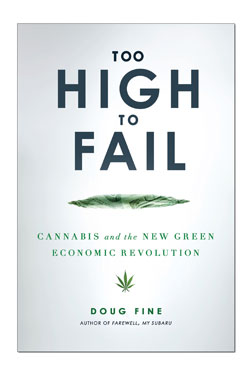Lighting up the pot debate
A look at legitimizing America’s No. 1 cash crop
by Tom Sluis
First, let’s be clear. This book is about pot. (“Yay!” say you local dopers). It’s about marijuana. (“Awesome!”) It’s even about weed. (“Totally, totally righteous dude.”)
First, let’s be clear. This book is about pot. (“Yay!” say you local dopers). It’s about marijuana. (“Awesome!”) It’s even about weed. (“Totally, totally righteous dude.”)
But hang on. Doug Fine’s Too High to Fail is really a dissertation by a Stanford-educated journalist about the economic impacts of the nation’s multi-billion dollar cannabis industry. (“Diser-whata?”) Fine lambastes the wasted financial opportunity that lies in the fields of carefully tended cannabis that represent millennia of carefully selected biogenetic manipulation. He describes his “delightful etymological time travel” through a yearlong investigation into what he sees as the possible beginnings of “Pax Cannabis.”

|
Just the Facts |
So this is not a book for the Jeff Spicolis of the world. And that’s OK. Because Fine, who also wrote Farewell, My Subaru, wants to bring back the historical legitimacy to the plant. Which, again, is not just for getting high. Thomas Jefferson wrote the first draft of the Declaration of Independence on cannabis paper. The Chinese have been using medical cannabis for thousands of years. The pioneers’ wagons were covered in cannabis cloth.
The plant can be converted into fuel or textiles. Cultivation of the cellulose-rich plant requires fewer pesticides and herbicides than cotton.
Additionally, alcohol and prescription medicine abuse cause far more problems for law enforcement than cannabis ever has, and driving cannabis underground is just accordingly a huge failure on all counts, according to Fine.
“Unless you are prepared to state that alcohol, tobacco, nicotine and most prescription depression and pain medicine should be aggressively and immediately prohibited in our society,” he writes, “You have no case arguing that cannabis does.” Legalizing cannabis should be a “national imperative.”
The title is an ironic evocation of the “Too Big to Fail” concept that certain financial institutions are so massive, so critical to the national economy that they cannot be allowed to fail without federal government intervention. A 2006 study claims cannabis is already the largest cash crop in the nation, worth about $36 billion, larger than corn and wheat combined. In cannabis-friendly California, tax on the plant’s production added $105 million to the state’s coffers in 2011. For Fine, the cannabis industry is already so huge that fair’s fair: federal intervention in the cannabis industry should mean legalization, which could add $47 billion annually in taxes to the suffering economy.
To make his case, Fine profiled a cannabis grower in California’s Mendocino County and specifically “Lucille,” one of the grower’s plants named after a somewhat cranky neighbor. Despite the bad vibes, Lucille the plant flourished, and ended up being worth about $10,000 when harvested, part of an $880,000 crop. The innovative permitting process set up by Mendocino County may represent the post-Drug War economy, according to Fine.
Legalize and regulate cannabis, remove the criminal element and let the states reap the benefits.
The only problem, cannabis production is still illegal on the federal level, and federal law still trumps state law. After Fine returned home, Mendocino stopped issuing cannabis permits to await the outcome of a lawsuit in Southern California over whether municipalities can regulate an illegal industry.
As fun as the book is to read, there are shortcomings. No mention is made of where the bulk of the Mendocino crop ends up, other than nebulous “patients” and two specific elderly people who suffer from cancer and arthritis. There is minimal mention of the cannabis growers’ profits and little breakdown of the growers’ overhead. There is also some borderline conspiracy theory found in the depiction of pharmaceutical companies, prison industries and law enforcement and drug-money laundering banks that oppose legalization because of various turf wars. Scant mention is paid to the potential downsides of smoking cannabis; cannabis has been around for thousands of years and well, Fine writes, it’s not for everyone. “It all comes down to personal and parental responsibility.” He jokes while he’s serious. Fine can easily juggle about 40 ideas simultaneously, but he sometimes ends up writing monkey-mind sentences that nest one topic within another (usually inside parentheses).
But I’m like, too totally harsh. Fine and his “Sweetheart” live on a goat farm in New Mexico and put their kids in hemp diapers, so some leniency must be granted. Besides, the book is filled with so many quips that the scattershot is all too easy to overlook. My favorite: How cannabis opponents say Northern California’s timber industry was ruined by “dirty hippies … and their orgasms.”
Stripped of the hyperbole, Too High to Fail has merit that cannot be ignored. The American Medical Association says cannabis has medicinal value, which contradicts the basis of the federal ban. The California Medical Association has called for cannabis’ full legalization. Making cannabis illegal only drives the profit into the hands of drug cartels, just like prohibition did in the United States in the 1920s. Cannabis arrests are at an all-time high (853,838 in 2010), but cannabis is also now the nation’s No. 1 cash crop.
It’s all good grist, and it’s hard not to sympathize with Fine’s zeal and romanticism. He never says whether he smokes cannabis – my bet is no – but he does mention that given the choice between a synthetic (suburban) life and one that allows him to “live by the seasons and notice the shooting stars” he prefers the “less synthetic.” It’s a choice that will resonate with Durango’s readers, cannabis smokers or not.

